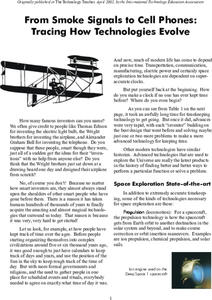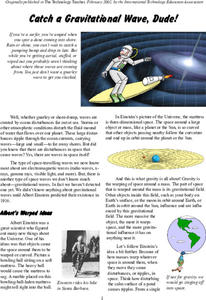NASA
From Smoke Signals to Cell Phones: Tracing How Technologies Evolve
Explore the science of space exploration. Pupils consider technological advances in propulsion, communication, power, navigation, and imaging. They select one of these areas and create a timeline of historical progress that contributed...
NASA
Water Works on a Blue Planet
Keep within a water budget. Learners find out that less than 2.5% of Earth's water is available to drink—and that there is a fixed amount of water. Scholars read an interesting article comparing the available water to a game of Monopoly...
NASA
Speaking in Phases
Hear from deep space. Pupils learn how satellites transfer information back to Earth. They learn about three different ways to modulate radio waves and how a satellite sends information with only 0s and 1s. Using sound, class members...
NASA
Blinded by the Light!
Pupils learn of multiple ways astronomers look for planets outside of the solar system. By completing a hands-on activity, scholars discover that trying to see the planets directly because of the glare from the nearby star is nearly...
NASA
Write the Book on Weather Metrics
It's not easy to measure the weather. Pupils learn about what all weather has in common—the atmosphere. Scholars discover how a meteorologists must be able to measure aspects of the atmosphere and decipher the data. They then create a...
NASA
Taking Apart the Light
Break down light into spectra. Scholars learn how atoms emit and absorb photons and come to understand how this process allows scientists to identify different atoms based on either absorption lines or emission lines. Learners then...
NASA
Catch a Gravitational Wave, Dude!
It is cowabunga time! Pupils read an article about the NASA LISA mission on gravitational waves and conduct additional research on them. The class participates in a science bowl type competition about gravitational waves. Panels of four...
NASA
Packing for a L-o-o-o-ng Trip to Mars
Pack just enough to fit. Crews determine what personal items to take with them on a trip to Mars. Each team must decide what to take with them on a two-and-a-half year trip to Mars and whether their items will fit within the allotted...
NASA
Taking a Cold, Clear Look at the Universe
Take a look with another perspective. Pupils read to find out what portion of the electromagnetic spectrum a space telescope sees and the difficulties of viewing infrared radiation from other objects in space. Individuals discover how...
NASA
Keeping Nine Eyes on the Weather
Take a look at climate change from another angle. Readers learn about the MISR instrument on the Terra satellite and how it studies Earth. Pupils experience how the multiple cameras give scientists multiple views so they can better study...
Other
Education World: Promoting Responsible and Ethical Digital Citizens
This article discusses ways teachers can train today's generation to be responsible and ethical life-long learners in the digital age. Topics include care of technology equipment, using reputable sites for studies and research, adhering...
Other
Critical Issue: Using Technology to Improve Student Achievement [Pdf]
NCREL provides a detailed report on the use of technology for student improvement. Click on Action Options and scroll down the area designated for teachers to view NCREL ideas on classroom implementation.
THEJournal
The Journal: Teachers Report Educational Benefits of Frequent Technology Use
Discusses a report on the use of technology in schools. The report surveyed over a thousand American educators for their thoughts on technology use. Teacher support and training were found to be key factors to successful integration of...
Smithsonian Institution
Smithsonian Education: Podcasting With Your Students
Here you can learn about ways that other teachers are doing with podcasting in the classroom. A tab on the left provides additional information about how to podcast
Edutopia
Edutopia: Redefining the Role of the Teacher
This article from Edutopia focuses on how students learn in the classroom. It discusses the shift in teaching from lecture-based in favor of student directed instruction.
Genome British Columbia
Genome British Columbia: Terminator Technology for Gm Crops
In 1998, American scientists developed terminator seeds which grew into plants that were unable to reproduce. While this practice prevents the dangerous flow of genes to the wild, it has some disadvantages, for example, the added expense...
North Central Regional Educational Laboratory
Assessing Young Children's Progress Appropriately
This article focuses on the critical issue of how to assess your young child's progress appropriately. Students, teachers and parents will benefit from this informative article. The article features contact information to learn more...
Genome British Columbia
Genome British Columbia: Sequencing
The structure of DNA is explained in detail, and the technology of DNA sequencing.
Khan Academy
Khan Academy: Philip Guo, Python Tutor and Writer
Phillip Guo is a computer science researcher and teacher specializing in human-computer interaction and educational technology. This article discusses how he became interested in his profession and what his job entails.













